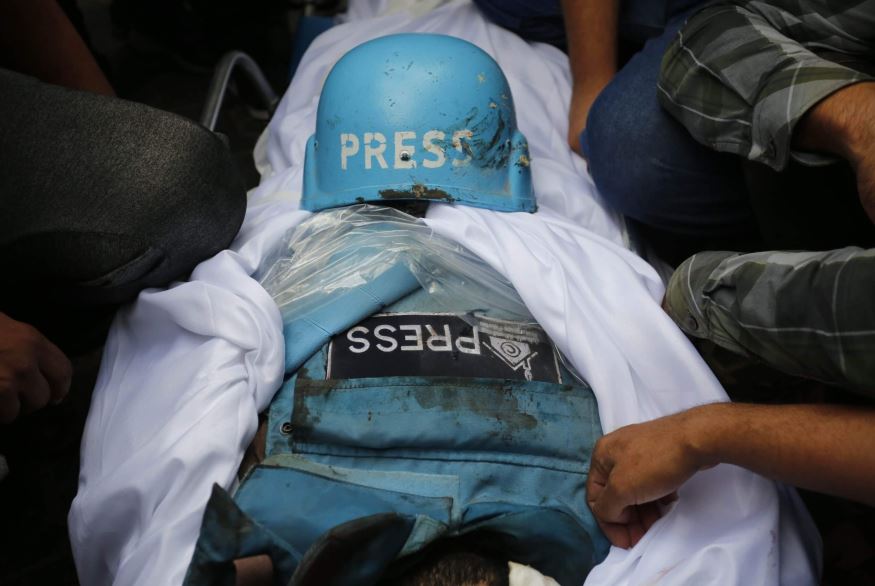Dr Pamelia Riviere
A Brown University study found Israeli attacks in Gaza since October 2023 have killed more journalists than all major U.S. and world wars combined. For instance, the U.S. Civil War, World Wars I and II, the Korean War, Vietnam War, the wars in Yugoslavia in the 1990s and 2000s, and the post-9/11 war in Afghanistan.
In the past 23 months, the conflict in Gaza has resulted in unprecedented fatalities among journalists. According to the Committee to Protect Journalists (CPJ), at least 189 journalists and media personnel have lost their lives since October 2023, making it the deadliest conflict for members of the press on record. Last week, five Palestinian journalists—Hussam al-Masri, Mariam Abu Dagga, Mohammed Salama, Ahmed Abu Aziz, and Moaz Abu Taha—were killed during a triple strike on Nasser hospital by Israeli forces. Other organizations report higher figures.
The Australian Broadcasting Corporation states that nearly 240 journalists have been killed in Gaza. On August 11, 2025, Al Jazeera reported Israel has killed over 270 journalists and media workers since its war on Gaza began.
The IDF asserted it had evidence that Sharif was affiliated with Hamas. The Committee to Protect Journalists (CPJ) and other organizations argue that this assertion is part of a larger trend of misinformation, alongside numerous instances where deceased journalists have been labeled as Hamas fighters or operatives, which they consider to be lacking in credibility.
The Israeli military has barred international journalists from entering and covering the conflict and has significantly weakened Gaza’s own media community. According to international law, journalists are recognized as protected civilians, yet the CPJ states that Israel is “engaging in the deadliest and most deliberate effort to kill and silence journalists that CPJ has ever documented.” the Guardian reported on September 01, 2025.
According to Al Jazeera on September 5, 2025, the Palestinian Journalists Syndicate reported that 15 journalists, including three women, were killed by Israeli forces in August, making it one of the deadliest months for media workers.
There was no ‘Hamas camera’: Netanyahu changed his tone
Tragically, five dedicated journalists lost their lives in a recent attack. Among them was Al-Masri, a contractor for Reuters, as well as Mariam Abu Dagga and Moath Abu Taha, both talented freelance visual journalists who collaborated with the Associated Press and Reuters throughout the ongoing conflict. Freelance journalist Ahmed Abu Aziz and Mohammad Salama, a cameraman for Al Jazeera, also perished, leaving a profound void in their communities.
The fourth-floor balcony and staircase area of the Nasser Hospital had long served as a vital vantage point for media professionals, including Reuters and the Associated Press, who used it as a live camera position. This location was not only crucial for broadcasting but was also a spot frequented by journalists seeking a strong cell signal to upload their compelling stories and documentation of the war. A poignant photograph taken on June 12 captures a moment of resilience, showcasing several journalists—including the two fallen, Mariam Abu Dagga and Moath Abu Taha—working diligently from the balcony, unaware of the impending tragedy.
Nevertheless, both Reuters and AP propagated the Israeli army’s assertion that a “Hamas camera” was the intended target without scrutinizing the narrative, even though their own staff were among the deceased. Valerie Zink, a photographer for Reuters, resigned in protest, claiming the agency was “propagating Israel’s narrative” following earlier fatalities, including that of Al Jazeera journalist Anas al-Sharif.
It was not a double tap; it was a triple tap that killed journalists
According to a report from CNN, Israel has been met with global condemnation following a series of strikes on the Nasser Hospital in Khan Younis, southern Gaza, this week. The attacks resulted in the deaths of at least 22 individuals, which included health care workers, emergency response personnel, and five journalists.
The strikes have elicited strong condemnation from numerous organizations, including the Committee to Protect Journalists (CPJ) and Doctors Without Borders (MSF). UN Secretary-General Antonio Guterres joined the chorus of voices decrying the violence, as did nations such as Canada, the UK, Germany, Switzerland, Qatar, Saudi Arabia, and Kuwait, all of whom firmly denounced the egregious attack on journalists simply fulfilling their duty to inform the world.
What’s the purpose of a double-tap or triple-tap strike?
On September 5, 2025, A British medic has vividly recounted the harrowing experience of a double-airstrike on the Nasser Hospital in southern Gaza, which occurred nine days ago. The hospital was not struck by a single missile; rather, it was hit by two consecutive shells, resulting in a tragic loss of life. In total, twenty individuals within the hospital premises were killed, including five journalists who were covering the ongoing crisis. Among the casualties was Dr. Rachael Moses, a dedicated respiratory physiotherapist from the United Kingdom. At the time of the attack, she was on the floor of the hospital, volunteering her expertise with a Medical Charity that provides vital support to Palestinians in need. This incident, which we reported at the time, underscores the severe impact of the conflict on healthcare facilities and the individuals working tirelessly to help those affected.
What is meant by a double-tap or triple-tap strike? Does it refer to ensuring the intended targets are neutralised? Additionally, is it permissible killing journalists under international law? This world must unite for peace; this is essential for humanity’s sake. Now is the time to come together for peace and conflict resolution, and to create an international protective force to safeguard journalists and Palestinians in Gaza.
The writer is a freelancer and analyst


